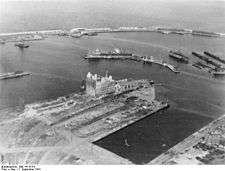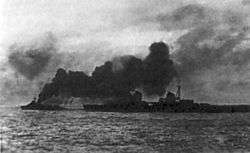Soviet evacuation of Tallinn
| ||||||||||||||||||||||||||||||
The Soviet evacuation of Tallinn, also called Tallinn disaster or Russian Dunkirk, was a Soviet operation to evacuate the 190 ships of the Baltic Fleet, units of the Red Army, and pro-Soviet civilians from the fleet's encircled main base of Tallinn in Soviet-occupied Estonia during August 1941.[1]
Soviet forces had occupied Estonia in June 1940. After the German invasion of the Soviet Union began on 22 June 1941, German forces advanced rapidly through the Soviet-occupied Baltic states, and by the end of August the Estonian capital of Tallinn was surrounded by German forces, while a large part of the Red Banner Baltic Fleet was bottled up in Tallinn harbour.
In expectation of a Soviet breakout, the Kriegsmarine and the Finnish Navy had started on 8 August 1941 to lay minefields off Cape Juminda on the Lahemaa coast. While Soviet minesweepers tried to clear a path for convoys through the minefields, German coastal artillery installed a battery of 150 mm (5.9 in) guns near Cape Juminda and the Finnish navy gathered their 2nd Motor Torpedo Boat Flotilla with patrol boats VMV9, VMV10, VMV11 and VMV17. At the same time the German 3. Schnellbootflottille with E-boats S-26, S-27, S-39, S-40 and S-101 was concentrated at Suomenlinna outside Helsinki. German Junkers Ju 88 bombers from Kampfgruppe 806 based on airfields in Estonia were put on alert. On 19 August the final German assault on Tallinn began.
During the night of 27/28 August 1941 the Soviet 10th Rifle Corps disengaged from the enemy and boarded transports in Tallinn.
The embarkation was protected by smoke screens, however, the mine-sweeping in the days before the evacuation began was ineffective due to bad weather, and there were no Soviet aircraft available for protecting the embarkation. This, together with heavy German shelling and aerial bombardment killed at least 1,000 of the evacuees in the harbor.
Gauntlet in the Gulf of Finland

Twenty large transports, eight auxiliary ships, nine small transports, a tanker, a tug, and a tender were organized into four convoys, protected by the Soviet cruiser Kirov, with Admiral Vladimir Tributs on board, two flotilla leaders, nine destroyers, three torpedo boats, twelve submarines, ten modern and fifteen obsolete minehunters, 22 minesweepers, 21 submarine chasers, three gun boats, a minelayer, thirteen patrol vessels and eleven torpedo boats.[2]
The armada started to move out at 22:00 on the evening of 27 August. Five ships were sunk on 28 August by German Ju 88 bombers.[2] At 16:00, 28 August, the first ship approached the heavily mined waters off Cape Juminda. The first ship to hit a mine and sink was the steamer Ella, and a few moments after her, several other ships hit mines, while German bombers and Finnish coastal artillery opened fire. In the attempt to force the passage the Soviet Navy lost five destroyers, two torpedo boats, a patrol vessel, three minehunters, three submarines, two gun boats, two smaller warships and fifteen transports. Two destroyers, a flotilla leader, a minehunter, and a transport were also damaged.[2]
Later that evening the armada was attacked by Finnish and German torpedo boats, and the chaotic situation made organized mine sweeping impossible. Darkness fell at 22:00 and the Soviet armada stopped and anchored at midnight in the heavily mined water.
Early on 29 August Ju 88 bombers attacked the remains of the convoys off Suursaari, sinking two transports. Meanwhile, the undamaged ships made best speed to reach the safety of the Kronstadt batteries. The heavily damaged merchant ship Kazakhstan disembarked 2300 men of the 5000 on board before steaming on to Kronstadt. In the following days ships operating from Suursaari rescued 12,160 survivors.[2]
The Soviet evacuation of Tallinn succeeded in evacuating 165 ships, 28,000 passengers and 66,000 tons of equipment.[3][4] At least 12,400 are thought to have drowned[5] in circumstances little known outside the former Soviet Union. The event was long downplayed by the Communist regime after the war. The evacuation may have been the bloodiest naval disaster since the battle of Lepanto.
On the sixtieth anniversary a memorial was unveiled at Juminda.[6]
Partial list of sunk ships

- Latvian Icebreaker Krišjānis Valdemārs
- Soviet Submarine S 5 - 28 August 1941, Gulf of Finland[7]
- Soviet Submarine Shch 301 - 28 August 1941, off Cape Juminda[7]
- Soviet Destroyer Yakov Sverdlov - 28 August 1941, off Mohni island[7]
- Soviet Destroyer Kalinin - 28 August 1941, off Cape Juminda[7]
- Soviet Destroyer Artem - 28 August 1941, off Cape Juminda[7]
- Soviet Destroyer Volodarski - 28 August 1941, off Cape Juminda[7]
- Soviet Destroyer Skoryi - 28 August 1941, off Cape Juminda[7]
- Patrol vessel Sneg - 28 August 1941, off Cape Juminda[7]
- Patrol vessel Tsiklon- 28 August 1941, off Cape Juminda[7]
- Gunboat I-8 - 28 August 1941, off Cape Juminda[7]
- Minesweeper No. 71 (Crab) - 28 August 1941, off Cape Juminda[7]
- Minesweeper No. 42 (Lenvodput-13) - 28 August 1941, off Cape Juminda[7]
- Guard ship Saturn
- Patrol boat MO 202
- Motor torpedo boat TK 103
- 25 large and 9 smaller merchantmen, most of them lost to mines:
- Estonian transport SS Eestirand (VT 532) - 24 August 1941, off Prangli Island
See also
References
- 1 2 Harrison E. Salisbury (2003). "Tallinn disaster; Russian Dunkirk". The 900 Days: The siege of Leningrad. Cambridge, MA: Da Capo Press. pp. 221–242.
- 1 2 3 4 Potter, Elmar P.; Nimitz, Chester W. (1986). "Der Krieg in der Ostsee" [The War at Sea in the Baltics]. In Rohwer, J. Seemacht. Eine Seekriegsgeschichte von der Antike bis zur Gegenwart [Sea Power. A Naval History]. Herrsching: Manfred Pawlak Verlagsgesellschaft mbH. pp. 602–622. ISBN 3-88199-082-8.
- ↑ Finnish navy in Continuation War, year 1941
- ↑ Naval War in the Baltic Sea 1941-1945
- ↑ "Juminda, 28.8.1941: To the memory of the drowned - all 12,000 of them" Helsingen Sanomat 5 September 2010
- ↑ Press Service of the Office of the President; Kadriorg, August 24, 2001
- 1 2 3 4 5 6 7 8 9 10 11 12 Krivosheev, G.F. (1997). Soviet Casualties and Combat Losses in the Twentieth Century. London: Greenhill Books. pp. 265–271. ISBN 1-85367-280-7.
Coordinates: 59°26′47″N 24°46′05″E / 59.446344°N 24.768033°E
